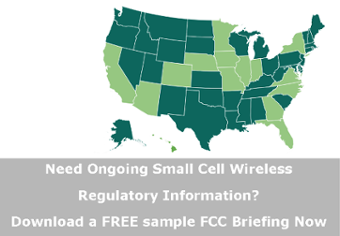 The FCC voted on a number of significant items at its April 20, 2017, Open Meeting. FCC Chairman Pai called April Infrastructure Month, but FCC Commissioner Clyburn suggested that it is instead Industry Consolidation Month. Which it is probably depends on whether you are an incumbent or competitive provider. So, here’s a quick recap of the three most contentious items adopted at the meeting. This blog is based on public documents released after the meeting and TMI notes from statements made at the meeting itself. See All three statements: Chairman Pai here; Commissioner Clyburn here, and from Commissioner O'Rielly here.
The FCC voted on a number of significant items at its April 20, 2017, Open Meeting. FCC Chairman Pai called April Infrastructure Month, but FCC Commissioner Clyburn suggested that it is instead Industry Consolidation Month. Which it is probably depends on whether you are an incumbent or competitive provider. So, here’s a quick recap of the three most contentious items adopted at the meeting. This blog is based on public documents released after the meeting and TMI notes from statements made at the meeting itself. See All three statements: Chairman Pai here; Commissioner Clyburn here, and from Commissioner O'Rielly here.
Removing Regulatory Barriers to Wireline Broadband Deployment
The FCC adopted an item that seeks comment on a series of steps to remove regulatory barriers to wireline broadband infrastructure deployment. The Notice of Proposed Rulemaking will seek comment on issues related to pole attachments and the retirement of copper networks.
Pole attachment reforms (aimed at making it easier for broadband providers to attach the wires necessary for next-generation networks), including:
- Adopting a streamlined timeframe for gaining access to utility poles by using elements of municipal “one-touch, make-ready” rules;
- Reducing make-ready charges;
- Codifying the elimination of certain capital costs;
- Establishing a shot clock for FCC consideration of pole attachment complaints;
- Adopting a formula for computing the maximum pole attachment rate that may be imposed on ILECs; and
- Adopting rules that would allow for all LECs to demand reciprocal access on other LEC-owned poles.
Copper network retirement reforms (aimed at reducing the regulatory burdens associated with retiring legacy copper network facilities) including:
- Streamlining copper retirement and reducing associated regulatory burdens to facilitate more rapid transition to IP networks by reducing the comment period and automatic grant timeframe;
- Streamlining and/or eliminating provisions of network change notification rules that may no longer be necessary;
- Eliminating rules requiring carriers to spend money to maintain outdated equipment; and
- Streamlining the approval process for discontinuance of legacy services.
 A Notice of Inquiry will seek comment on using the FCC’s preemption authority to prospectively prohibit the enforcement of state and local laws that pose barriers to broadband deployment. Examples of such laws are moratoria on market entry or the deployment of new facilities and excessive fees. A Request for Comment will seek input on when carriers must obtain FCC permission to alter or discontinue a service.
A Notice of Inquiry will seek comment on using the FCC’s preemption authority to prospectively prohibit the enforcement of state and local laws that pose barriers to broadband deployment. Examples of such laws are moratoria on market entry or the deployment of new facilities and excessive fees. A Request for Comment will seek input on when carriers must obtain FCC permission to alter or discontinue a service.Commissioner Clyburn said she was issuing a concurring statement (not released at the time of this blog). Based on her remarks at the meeting, she is concerned about the Order’s effort to “roll back the carefully considered efforts of the past administration” regarding technology transitions and is concerned that the decision will harm those consumers that would prefer to retain their legacy services.
Removing Regulatory Barriers To Wireless Infrastructure Deployment
The FCC also adopted an item aimed at identifying and addressing unnecessary regulatory barriers to wireless infrastructure deployment, with the goal of promoting the rapid deployment of advanced wireless broadband service to all Americans. Among other things, the Notice of Proposed Rulemaking will examine how state and local processes affect the speed and cost of infrastructure deployment. Based on the publicly released information, it will ask for comment on:
- Improving and speeding up state and local infrastructure reviews, such as zoning requests;
- Whether siting applications that are not acted on by state or local governments within a reasonable period of time should be “deemed granted” by the FCC;
- The costs and benefits inherent in the FCC’s historic preservation and environmental review processes as currently structured, including changes that could be made to minimize costs and delays;
- Whether certain categories and facilities, such as small cell sites, still need individual environmental, or historic preservation review; and
- Ways to enable collocation on certain towers built between 2000 and 2005 that may not have completed environmental review.
The Notice of Inquiry asks for comment on two provisions of the Communications Act, Sections 253 and 332, that acknowledge the importance of state and local regulation, but also protect against regulations that impose barriers to entry or are otherwise unreasonable.
Business Data Service Reform
The FCC adopted a Report and Order that substantially revises the pricing rules for business data services (BDS). (BDS are dedicated connectivity used by businesses, nonprofits, and government institutions to meet their needs for secure and reliable communications. Lower bandwidth services, such as DS1s and DS3s, are a segment of the BDS market referred to as special access. Traditional special access services offered by ILECs have long been subject to FCC price regulation. These legacy networks operate on copper-based TDM technologies at relatively low speeds, and in the FCC’s words are “becoming increasingly obsolete.”)
Relying on more than ten years of study of the market, a massive data collection, and a robust public record, the FCC found strong competition present in the BDS market. Given that competition, the FCC concluded that legacy regulation inhibits the investment required for the transition of BDS from legacy TDM networks to high-speed Ethernet connectivity.
According to publicly released documents, the key findings and resulting changes include the following:
- Competition for packet-based services at speeds exceeding 45 Megabits per second (the top speed of TDM DS3 services) and TDM transport services is widespread, making pricing regulation for these services “counterproductive;”
- Continued price regulation for legacy TDM-based BDS in areas deemed competitive may stifle investment and inhibit the transition to modern IP services. Thus, the FCC adopted a competitive market test which determines that pricing regulation is no longer required when either of the following conditions are met:
- 50% of the buildings in a county are within a half-mile of a location served by a competitive provider, or
- 75% of the census blocks in a county have a cable provider present
- After a 36-month transition period, ILECs in counties meeting the competitive market test will no longer file tariffs with the FCC. However, rates must continue to be just and reasonable.
- In counties that do not meet the competitive market test, price regulation will be retained for lower speed TDM connections to end-users. However, ILECs will be allowed to offer volume and term discounts, as well as contract tariffs (known as “Phase I pricing flexibility” under the FCC’s old rules).
- The Order levels the regulatory playing field for ILECs by extending uniform forbearance from certain rules that had previously been granted unevenly. This change includes forbearance from tariffing for all packet-based BDS.
- The Order updates price cap regulation where it remains by reducing the cap annually by 2% on a going-forward basis to account for productivity gains (known as the “X-factor”). While the X factor has not been adjusted since 2005, when it was set at the rate of inflation, the Order concludes that no catch-up adjustment is warranted since inflation offset productivity gains for TDM services. The new X-factor takes effect on December 1, 2017.
- Packet-based and TDM telecommunications services continue to be subject to statutory requirements that rates, terms, and conditions be just and reasonable, and enforceable through the complaint process.
- The Order also concludes that certain business data services constitute private carriage rather than common carriage.
Commissioner Clyburn read excerpts from a vigorous dissent, not available at the time this blog, which said the Order “puts a hefty nail in the coffin of wireline competition,” “undermines the market opening goals of the 1996 Telecommunications Act,” and “paves the way for less competition and more industry consolidation.” She said the Order was “one of the worst I have seen in my nearly eight years at this Commission. It is abhorrent that the policy goal is deregulation at all costs…” and concluded with a statement that: “Given the substantial likelihood of market harm, I believe the order is at a substantial risk of judicial stay. This order deepens the digital divide and communities where competition is unlikely to ever develop will see substantial deregulation, higher prices and absolutely no hope of relief.”





